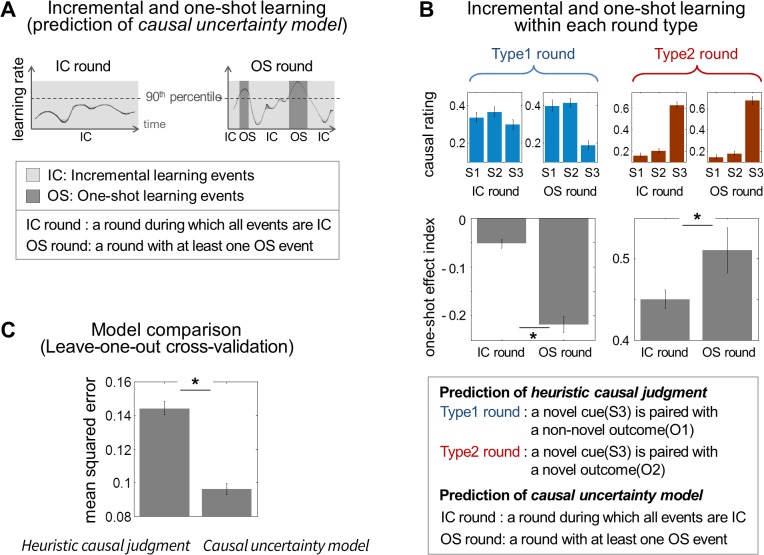Fig 4. Model predictions.
(A) Causal uncertainty model’s prediction about incremental and one-shot learning. Since the model provides event-by-event predictions about learning rate for each stimulus, we split events into two subtypes: “one-shot learning events” (OS), which refers to a stimulus presentation during which the model predicts rapid learning (>90th percentile) and “incremental learning events” (IC), which refers to a stimulus presentation during which the model predicts otherwise (<90th percentile). Accordingly, an “OS round” is defined as a round during which the model predicts occurrence of OS, and an “IC round” is defined as a round during which the model predicts no occurrence of OS. (B) The causal uncertainty model’s predictions that are beyond the predictions of the heuristic causal judgment, which draws a distinction between each round type—type1 and type2 rounds. For type1 rounds during which the model predicts occurrence of one-shot learning events (“OS round” in the type1 round), the corresponding one-shot effect index is significantly more negative than for type1 rounds during which the model predicts no occurrence of one-shot learning events (“IC round” in the type1 round), indicating that when one-shot learning occurs in the type1 rounds, with a high degree of certainty, participants attribute a novel outcome to non-novel stimuli, as opposed to the novel stimulus. On the other hand, for type2 rounds during which the model predicts the occurrence of one-shot learning events (refer to “OS round” in the type2 round), the corresponding one-shot effect index is greater than the type2 rounds during which the model predicts no occurrence of one-shot learning (refer to “IC round” in the type2 round). In both cases, one-shot effects are more dramatic when one-shot learning occurs during the round. *: p < 0.05; error bars are SEM across subjects. (C) Model comparison. Leave-one-out cross validation was used to validate the generalization performance of the models. The causal uncertainty model refers to the causal learning model proposed in the present study, and the heuristic causal judgment refers to the simpler heuristic model taking the stimulus-outcome novelty pairings into account assuming that causal uncertainty is high whenever stimulus and outcome novelty is high.
*: p < 0.01; error bars are SEM across subjects.

